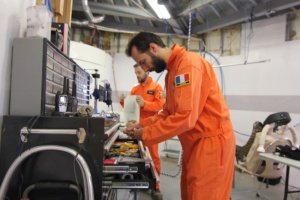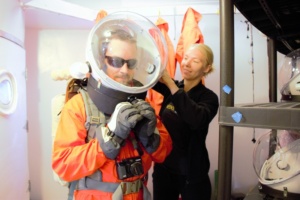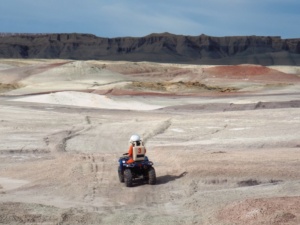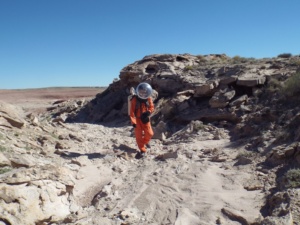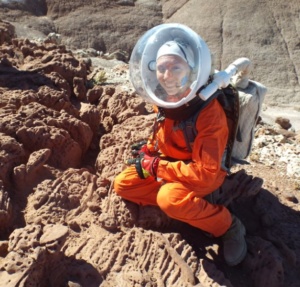EVA Narrative – November 4th
WHAT’S IT LIKE TO WEAR A (SIMULATED) EVA SUIT?
Jon Clarke
Putting on the simulated space suits we use at MDRS is a very different experience to just going outside casually, even when the goal – be it science or engineering – is similar.
First you have to suit up. We wear orange flight suits over our clothes. How many clothes you will wear underneath depends on the outside temperature. But it can get very hot in the suits even when the temperature is pleasant outside. The backpack, which contains our ventilation system and batteries, weighs 12 kg. With the helmet it weights 13 kg. With radio, boots, and clothes your total load is 15 kg, not counting tools and emergency equipment. When these are included you can be carrying loads similar to the Apollo astronauts on the Moon. Everything has to be put on in the right order with help, the radios and head pieces tested, and all our equipment assembled. The backpacks and helmet rings need careful adjustment or you soon end up with sore shoulders, stiff back, a sore neck –or all three.
Then you can cycle yourself through the airlock, which involves a five minute wait in the airlock. Maybe your crew pipes some appropriate music over the radio, maybe not. Then you can head off, either on foot or on the quadbikes. If you have forgotten something, you either have do without, or wait for it to be cycled through the airlock.
The very first thing you are aware of is time. While the batteries that power our air supply are good for six hours, perhaps more, the big constraint for is often water. There is no water supply in the suit and, when the weather is warm, as it has been, you can get thirsty really fast, dehydrating at a rate of up to half litre an hour. So you need to plan all our work within a constraint of 3-4 hours. You look forward to cooler weather and perhaps being able to stay out longer. Every breath, every step, is distinctly closer to the time you have to come back inside. It’s not as extreme when scuba diving, but the mindset you need is similar.
The second thing you are aware of is enclosure. The helmets cut you off from most outside sounds, the main noises you do hear are the radio in your ear and the hum of the fans – a very comforting sound. You are isolated from the wind-and the cooling breeze. Your vision is limited, you can’t see sideways without turning your whole body, your feet without bending over, your body, arms, and legs at all. There are usually some dust, smears and scratches on your lexan bubble, increasing glare. The lexan is also not entirely even, so the view ripples slightly as you move. Us older people with multi-focals are used to this, but is disconcerting to some younger users! The boots limit your sense of contact with ground and the gloves your dexterity and tactility. You can’t inspect things closely, or blow dust off a rock or your camera lens.
Over easy ground your mobility is mostly unrestricted, not unlike hiking with a heavy backpack. You need to be aware of your larger size and mass, and of course poorer vision. You have to be careful not to over-exert yourself, the fans supply fresh air at a fixed rate and CO2 and water vapour is flushed out at a complex rate out the bottom of the next ring. So if you over do things you end up with CO2 build up and helmet fogging. It’s not like a scuba unit with a demand valve. So you have to pace yourself, especially as the ground gets steeper. Take your time!
On rough terrain, whether flat or sloping, you have to be really careful. If you fall over you could end up with face, neck, back, and limb injuries, or all of these. So must you think about your size, balance, where your feet are, and what’s underfoot at all times. Again, take your time, don’t hurry, again think every step through before you take it.
At least the suits are flexible, unlike real gas-pressure suits. You can bend over, sit, kneel and climb. But maybe on Mars you would be using a mechanical counter pressure suit, which will be much more flexible, and more like what you are wearing. The life support system on your back might be lighter too!
Communications are by UHF radios with push-to-transmit control. Those not used to radio discipline soon learn not to talk over the top of each other! Voice activated radios (VOX) would be better, but the VOX setting is not reliable. Transmission range is limited in the terrain round MDRS so once you are more than a few hundred from the station the EVA team is on its own!
Eventually all this becomes familiar and you start to enjoy the experience. The interior of your suit becomes an intimate, personal space, even cosy. Going outside on an out-of-sim day feels strange and unnatural . Seeing other people – tourists – without suits is something of a shock. When you reach this mental level you know you have really arrived, psychologically speaking, on Mars!




